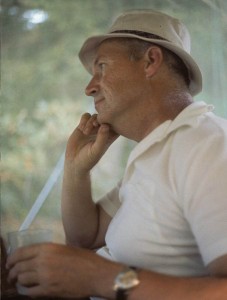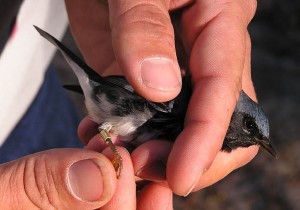Walter Post Smith and his Kiptopeke Chronicles
New professorship honors Mitchell A. Byrd
October 9, 2008Aerial survey of the Pacific coast of Panama for waterbirds completed
October 11, 2008
Written by Bryan Watts
October 10, 2008

Author and birder, Walter Post Smith. Photo by Jose E. Hernandez.
Each of us in our own way and time seek out vantage points on the natural world. Places where unleashed from the past and unencumbered by the future, we are free to explore the innermost reaches of ourselves. For Walter Post Smith, this place was Kiptopeke, Virginia. Along with Fred Scott, Charlie Hacker, and Mike Mitchell, Walter was one of four bird banders who founded the Kiptopeke Banding Station. He was there during the first week of operation in September of 1963. Walter would continue to be associated with the station for nearly 40 years. He often stated that he felt more alive there than anywhere else in the world.

Banding the 300,000th bird at Kiptopeke Banding Station, a black-throated blue warbler. Photo by Bryan Watts.
Walter Smith was born in Newport News, Virginia and was a lifelong resident of Hampton Roads. A draftsman by trade, Walter loved ships and worked for Newport News Shipbuilding for his entire career. After his first encounter with fall migration he was captivated by Kiptopeke. After retirement, Walter spent several weeks each fall living on the Eastern Shore and banding at the Kiptopeke Station. His enthusiasm for this place and for the birds that stopped there during migration was infectious and attracted dedicated volunteers from a broad geographic area. He spent much of the year planning and preparing for the fall season. Particularly from the late 1960s through the 1980s, Walter was the glue that held the station together.

Walter and Doris Smith on an outing in later years. Photo by Dick Davis.

Walter Smith (right) with banding helpers at Kiptopeke Banding Station. Photo by Mitchell Byrd.
Now operated by the Coastal Virginia Wildlife Observatory, the Kiptopeke Banding Station has banded more birds during fall migration than any station in North America. On 17 October 2005 the station reached a milestone, banding its 300,000th bird, fittingly, a hatching-year, male Black-throated Blue Warbler.
For more than 4 decades the station has collected valuable information on bird populations migrating along the Atlantic Coast and has provided thousands of individuals with the opportunity to see birds in the hand. For most years, at the close of the banding season, Walter wrote his reflections on the operations of the banding station. Before his death in 2004 he compiled these stories into a book titled Kiptopeke Chronicles. The book is a history of the development of the Kiptopeke Banding Station through the eyes of someone who was there from the beginning. More than a diary, the volume is a memoir of a person who enjoyed the energy of migrants passing through the woods on a fall day.

Walter reviewing banding records at Kiptopeke. Photo by Jose E. Hernandez.
“Yet, I constantly found beauty there— in the wake-up calls of the Screech and Great Horned Owls, in the thin chips of Warblers and the rich chirps of the Thrushes coming in overhead, and even in the loneliness of some mornings when I was trying to guess how much help might show up, and how many nets I could safely open. There were times when visitors commented on my supposedly dogged dedication to the Banding Station— but they had it all wrong. There I was, doing every day what I loved best of all, and wasn’t I the lucky one to have it that way!”
The book reveals Walter’s day to day passion for and dedication to a cause, but also to the people of Kiptopeke and in his life more broadly. Walter Smith’s memoir will appeal to bird banders, visitors to Virginia’s Eastern Shore, and anyone who appreciates a journey back in time, to the good old days.

The cover of Walter Post Smith’s memoir, Kiptopeke Chronicles. Photography: Jose E. Hernandez; Cover design: Marian Urbi Watts. Photo by Jose E. Hernandez, Mairan Watts.
The Center for Conservation Biology (CCB) has published Walter Post Smith’s Kiptopeke Chronicles with the assistance of Walter’s widow, Doris Smith and Aventine Press.
Click here to order Kiptopeke Chronicles from Amazon.com.
Related posts
October 8, 2025
October 8, 2025
October 8, 2025



